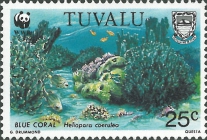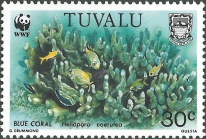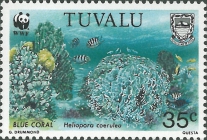Traits taxon details
Heliopora coerulea (Pallas, 1766)
210725 (urn:lsid:marinespecies.org:taxname:210725)
accepted
Species
Heliopora coerulea meandrina Dana, 1846 · unaccepted > junior subjective synonym
Heliopora coerulea tuberosa Dana, 1846 · unaccepted > junior subjective synonym
Heliopora meandrina Dana, 1846 · unaccepted > junior subjective synonym
- Subspecies Heliopora coerulea meandrina Dana, 1846 accepted as Heliopora coerulea (Pallas, 1766) (unaccepted > junior subjective synonym)
- Subspecies Heliopora coerulea tuberosa Dana, 1846 accepted as Heliopora coerulea (Pallas, 1766) (unaccepted > junior subjective synonym)
marine, fresh, terrestrial
recent + fossil
(of ) Pallas, P. S. (1766). Elenchus zoophytorum sistens generum adumbrationes generaliores et specierum cognitarum succintas descriptiones, cum selectis auctorum synonymis. [List of zoophytes containing general outlines of genera and brief descriptions of known species, with selected synonyms of the authors.]. <em>Fransiscum Varrentrapp, Hagae.</em> 451 pp., available online at https://www.biodiversitylibrary.org/page/6019361 [details] 
McFadden, C.S.; Cordeiro, R.; Williams, G.; van Ofwegen, L. (2024). World List of Octocorallia. Heliopora coerulea (Pallas, 1766). Accessed through: Marine Species Traits editorial board (2024) Marine Species Traits at: https://www.marinespecies.org/traits./aphia.php?p=taxdetails&id=210725 on 2025-04-04
Marine Species Traits editorial board (2025). Marine Species Traits. Heliopora coerulea (Pallas, 1766). Accessed at: https://www.marinespecies.org/traits/aphia.php?p=taxdetails&id=210725 on 2025-04-04
Date
action
by
original description
(of ) Pallas, P. S. (1766). Elenchus zoophytorum sistens generum adumbrationes generaliores et specierum cognitarum succintas descriptiones, cum selectis auctorum synonymis. [List of zoophytes containing general outlines of genera and brief descriptions of known species, with selected synonyms of the authors.]. <em>Fransiscum Varrentrapp, Hagae.</em> 451 pp., available online at https://www.biodiversitylibrary.org/page/6019361 [details] 
original description (of Heliopora coerulea tuberosa Dana, 1846) Dana, J.D. (1846-1847). On Zoophytes. <em>The American Journal of Science and Arts, Second Series.</em> 2(4): 64-69; 2(5): 187-202; 3(7): 1-24; 3(8): 160-163; 3(9): 337-347. New-Haven., available online at https://www.biodiversitylibrary.org/page/28135503
page(s): 540 [details]
original description (of Heliopora coerulea meandrina Dana, 1846) Dana, J.D. (1846-1849). Zoophytes. United States Exploring Expedition during the years 1838-1842. <em>Lea and Blanchard, Philadelphia.</em> 7: 1-740, 61 pls. (1846: 1-120, 709-720; 1848: 121-708, 721-740; 1849: atlas pls. 1-61)., available online at https://www.biodiversitylibrary.org/page/18989497, http://www.sil.si.edu/digitalcollections/usexex/navigation/ScientificText/USExEx19_08select.cfm [details]
basis of record Veron JEN. (1986). Corals of Australia and the Indo-Pacific. <em>Angus & Robertson Publishers.</em> [details]
additional source Williams, G.C. (1992). Biogeography of the octocorallian coelenterate fauna of southern Africa. <em>Biol. J. Linn. Soc.</em> 46: 351-401.
page(s): 397 [details] Available for editors
additional source Quoy, J. R. C.; Gaimard, J. P. (1833). Zoologie IV: Zoophytes. In:Zoologie. Voyage de la corvette l'Astrolabe : exécuté par ordre du roi, pendant les années 1826-1827-1828-1829 / sous le commandement de J. Dumont d'Urville. pp. 1-390. Paris, J. Tastu., available online at https://www.biodiversitylibrary.org/page/2064339
page(s): 252-254 [details]
additional source Dana, J.D. (1846-1847). On Zoophytes. <em>The American Journal of Science and Arts, Second Series.</em> 2(4): 64-69; 2(5): 187-202; 3(7): 1-24; 3(8): 160-163; 3(9): 337-347. New-Haven., available online at https://www.biodiversitylibrary.org/page/28135503
page(s): 540-541 [details]
additional source van der Land, J. (ed). (2007). as a contribution to UNESCO-IOC Register of Marine Organisms. , available online at http://www.marinespecies.org/urmo [details]
additional source Liu, J.Y. [Ruiyu] (ed.). (2008). Checklist of marine biota of China seas. <em>China Science Press.</em> 1267 pp. (look up in IMIS) [details] Available for editors
additional source Umbgrove JHF. (1939). Madreporaria from the Bay of Batavia. <em>Zoologische Mededelingen, Leiden.</em> 22: 1-64.
page(s): 8, 9 [details]
additional source Yabe H, Sugiyama T. (1935). Revised list of the reef-corals from the Japanese seas and of the fossil reef corals of the raised reefs and the Ryukyu limestone of Japan. <em>Journal of the Geological Society of Japan.</em> 42: 379-403.
page(s): 387, 391, 401 [details]
additional source Dana, J.D. (1846-1849). Zoophytes. United States Exploring Expedition during the years 1838-1842. <em>Lea and Blanchard, Philadelphia.</em> 7: 1-740, 61 pls. (1846: 1-120, 709-720; 1848: 121-708, 721-740; 1849: atlas pls. 1-61)., available online at https://www.biodiversitylibrary.org/page/18989497, http://www.sil.si.edu/digitalcollections/usexex/navigation/ScientificText/USExEx19_08select.cfm
page(s): 540-541 [details]
additional source Crossland C (1952) Madreporaria, Hydrocorallinae, Heliopora and Tubipora. Scientific Report Great Barrier Reef Expedition 1928-29 VI(3): 85-257.
page(s): 95, 250 [details]
additional source Matthai G (1924) Report on the madreporarian corals in the collection of the Indian Museum, Calcutta. Memoirs of the Indian Museum 8: 1-59.
page(s): 11 [details]
additional source Bayer, F.M., Muzik, K.M. (1977). An Atlantic helioporan coral (Coelenterata: Octocorallia). <em>Proceedings of the Biological Society of Washington.</em> 90: 975–984., available online at https://repository.si.edu/bitstream/handle/10088/975/Bayer-072-1977-pg-975-984.pdf?sequence=1&isAllowed=y
page(s): 976, 978, 981 [details] Available for editors
additional source Alderslade, P. (2001). Six new genera and six new species of soft coral, and some proposed familial and subfamilial changes within the Alcyonacea. <em>Bulletin of the Biological Society of Washington.</em> 10:15-65.
page(s): 63 [details] Available for editors
additional source Faustino LA. (1927). Recent Madreporaria of the Philippine Islands. <em>Bureau of Science Manila Monograph.</em> 22: 1-310, pls. 1-100.
page(s): 21, 27, 42, 298-299 [details]
additional source Benayahu, Y. (1995). Species composition of soft corals (Octocorallia, Alcyonacea) on the coral reefs of Sesoko Island, Ryukyu Archipelago, Japan. <em>Galaxea.</em> 12: 103–124.
page(s): 119 [details]
additional source Utinomi, H. (1971). Intertidal alcyonarians in the vicinity of Darwin, Northern Territory, Australia. <em>Records of the Australian Museum.</em> 28(5): 87-110, plates 15-16.
page(s): 88, 107, 110 [details]
additional source Tixier-Durivault, A. (1972). Nouvel apport d'Octocoralliares de Madagascar et des iles avoisinantes. <em>Tethys.</em> Suppl. 3: 11-68., available online at http://paleopolis.rediris.es/benthos/REF/som/T-pdf/1972_s3-11.pdf
page(s): 32 [details] Available for editors
additional source Utinomi, H. (1953). Invertebrate fauna of the intertidal zone of the Tokara Islands. VI. Alcyonaria. <em>Publications of the Seto Marine Biological Laboratory.</em> 3(2): 149-160.
page(s): 159 [details]
additional source Utinomi, H. (1956). On some alcyonarians from the West-Pacific islands (Palau, Ponape and Bonins). <em>Publications of the Seto Marine Biological Laboratory.</em> 5(2): 221-242.
page(s): 236 [details]
additional source Utinomi, H. (1959). Fleshy alcyonarians from southern Formosa. <em>Publications of the Seto Marine Biological Laboratory.</em> 7(3): 303-312.
page(s): 309 [details]
additional source Imahara, Y. (1991). Report on the Octocorallia from the Ryukyu Islands of Japan. <em>Bull. Inst. Oceanic Res. & Develop., Tokai Univ.</em> 11/12: 59-94.
page(s): 83 [details]
additional source Umbgrove JHF. (1929). Anthozoa van N.O. Borneo. <em>Wetenschappelijke Mededeelingen van den Dienst van den Mijnbouw in Nederlandsch-Indië.</em> 9: 47-87, pls. 1-5. [details]
additional source Bouillon J. Houvenaghel-Crevecoeur N. (1970). Étude monographique du genre Heliopora de Blv. <em>Annales Musée royal de lʼAfrique centrale, Series 8.</em> 178: 1-83. [details]
additional source Eguchi M. (1948). Fossil Helioporidae from Japan and the South Sea Islands. <em>Journal of Paleontology.</em> 22 (3): 362-364. [details]
additional source Bourne, G.C. (1895). On the structure and affinities of Heliopora coerulea, Pallas. With some observations on the structure of Xenia and Heteroxenia. <em>Philosophical Transactions of the Royal Society of London, Series B.</em> 186: 455-483, plates 10-13., available online at https://royalsocietypublishing.org/doi/10.1098/rstb.1895.0009 [details]
additional source Opresko, D.M. & F.M. Bayer. (1991). Rediscovery of the enigmatic coelenterate Dendrobrachia (Octocorallia: Gorgonacea) with descriptions of two new species. <em>Transactions of the Royal Society of South Australia.</em> 115(1): 1-19., available online at https://www.biodiversitylibrary.org/page/41148648
page(s): 13 [details] Available for editors
additional source Wells JW. (1954). Recent corals of the Marshall Islands: Bikini and nearby atolls, part 2, oceanography (biologic). <em>U.S. Geological Survey Professional Paper.</em> 260(I): 385-486.
page(s): 395, 396, 397, 399, 400, 474-475, pls. 169, 181, 182 [details]
additional source Grasshoff, M.; Bargibant, G. (2001). Coral Reef Gorgonians of New Caledonia. IRD Èditions. Paris., pp. 335.
page(s): 38, 39, 312, 313 [details]
additional source Sheppard, C. R. C. (1985). Fringing reefs in the southern region, Jeddah to Jizan. Fauna of Saudi Arabia, 7, 37-58
page(s): 48 [details]
additional source Fabricius, K.; Alderslade, P. (2001). Soft Corals and Sea Fans: A Comprehensive Guide to the Shallow-water Genera of the Central-West Pacific, the Indian Ocean and the Red Sea. <em>Australian Institute of Marine Science. Townsville.</em> pp. 264.
page(s): 6 [details]
additional source Tixier-Durivault, A. (1940). Contribution a l'étude du métabolisme du calcium et du fer chez l'Alcyonium palmatum Pallas. Annales de l'Institute Oceanographique, 20(1): 311-379, plate 1
page(s): 370, 371, 373 [details]
additional source Benayahu, Y.; Jeng, M. S.; Perkol-Finkel, S.; Dai, C. F. (2004). Soft corals (Octocorallia: Alcyonacea) from southern Taiwan. II. Species diversity and distributional patterns. Zoological Studies, 43(3): 548-560
page(s): 549, 550 [details]
additional source Achituv, Y.; Benayahu, Y.; Hanania, J. (1992). Planulae brooding and acquisition of zooxanthellae in Xenia macrospiculata (Cnidaria: Octocorallia). Helgoländer Meeresuntersuchungen, 46, 301-310
page(s): 308 [details]
additional source Reinicke, G. B.; van Ofwegen, L. P. (1999). Soft corals (Alcyonacea: Octocorallia) from shallow water in the Chagos Archipelago: species assemblages and their distribution. Linnean Society Occasional Publications, 2, 67-85, plates 1-10
page(s): 68, 71, 84 [details]
additional source Imahara, Y. (1996). Previously recorded octocorals from Japan and adjacent seas. Precious Corals and Octocoral Research, 4-mei, 17-44
page(s): 37 [details]
additional source Dana, J. D. (1849). Atlas. Zoophytes. C. Sherman. Philadelphia., pp. 12-01
page(s): 10, 540 [details]
additional source Bayer, F. M. (1992). The helioporacean octocoral Epiphaxum, recent and fossil: a monographic iconography. Studies in Tropical Oceanography, 15, 1-76
page(s): 8, 9, 46, 55 [details] Available for editors
original description (of Heliopora coerulea tuberosa Dana, 1846) Dana, J.D. (1846-1847). On Zoophytes. <em>The American Journal of Science and Arts, Second Series.</em> 2(4): 64-69; 2(5): 187-202; 3(7): 1-24; 3(8): 160-163; 3(9): 337-347. New-Haven., available online at https://www.biodiversitylibrary.org/page/28135503
page(s): 540 [details]
original description (of Heliopora coerulea meandrina Dana, 1846) Dana, J.D. (1846-1849). Zoophytes. United States Exploring Expedition during the years 1838-1842. <em>Lea and Blanchard, Philadelphia.</em> 7: 1-740, 61 pls. (1846: 1-120, 709-720; 1848: 121-708, 721-740; 1849: atlas pls. 1-61)., available online at https://www.biodiversitylibrary.org/page/18989497, http://www.sil.si.edu/digitalcollections/usexex/navigation/ScientificText/USExEx19_08select.cfm [details]
basis of record Veron JEN. (1986). Corals of Australia and the Indo-Pacific. <em>Angus & Robertson Publishers.</em> [details]
additional source Williams, G.C. (1992). Biogeography of the octocorallian coelenterate fauna of southern Africa. <em>Biol. J. Linn. Soc.</em> 46: 351-401.
page(s): 397 [details] Available for editors
additional source Quoy, J. R. C.; Gaimard, J. P. (1833). Zoologie IV: Zoophytes. In:Zoologie. Voyage de la corvette l'Astrolabe : exécuté par ordre du roi, pendant les années 1826-1827-1828-1829 / sous le commandement de J. Dumont d'Urville. pp. 1-390. Paris, J. Tastu., available online at https://www.biodiversitylibrary.org/page/2064339
page(s): 252-254 [details]
additional source Dana, J.D. (1846-1847). On Zoophytes. <em>The American Journal of Science and Arts, Second Series.</em> 2(4): 64-69; 2(5): 187-202; 3(7): 1-24; 3(8): 160-163; 3(9): 337-347. New-Haven., available online at https://www.biodiversitylibrary.org/page/28135503
page(s): 540-541 [details]
additional source van der Land, J. (ed). (2007). as a contribution to UNESCO-IOC Register of Marine Organisms. , available online at http://www.marinespecies.org/urmo [details]
additional source Liu, J.Y. [Ruiyu] (ed.). (2008). Checklist of marine biota of China seas. <em>China Science Press.</em> 1267 pp. (look up in IMIS) [details] Available for editors
additional source Umbgrove JHF. (1939). Madreporaria from the Bay of Batavia. <em>Zoologische Mededelingen, Leiden.</em> 22: 1-64.
page(s): 8, 9 [details]
additional source Yabe H, Sugiyama T. (1935). Revised list of the reef-corals from the Japanese seas and of the fossil reef corals of the raised reefs and the Ryukyu limestone of Japan. <em>Journal of the Geological Society of Japan.</em> 42: 379-403.
page(s): 387, 391, 401 [details]
additional source Dana, J.D. (1846-1849). Zoophytes. United States Exploring Expedition during the years 1838-1842. <em>Lea and Blanchard, Philadelphia.</em> 7: 1-740, 61 pls. (1846: 1-120, 709-720; 1848: 121-708, 721-740; 1849: atlas pls. 1-61)., available online at https://www.biodiversitylibrary.org/page/18989497, http://www.sil.si.edu/digitalcollections/usexex/navigation/ScientificText/USExEx19_08select.cfm
page(s): 540-541 [details]
additional source Crossland C (1952) Madreporaria, Hydrocorallinae, Heliopora and Tubipora. Scientific Report Great Barrier Reef Expedition 1928-29 VI(3): 85-257.
page(s): 95, 250 [details]
additional source Matthai G (1924) Report on the madreporarian corals in the collection of the Indian Museum, Calcutta. Memoirs of the Indian Museum 8: 1-59.
page(s): 11 [details]
additional source Bayer, F.M., Muzik, K.M. (1977). An Atlantic helioporan coral (Coelenterata: Octocorallia). <em>Proceedings of the Biological Society of Washington.</em> 90: 975–984., available online at https://repository.si.edu/bitstream/handle/10088/975/Bayer-072-1977-pg-975-984.pdf?sequence=1&isAllowed=y
page(s): 976, 978, 981 [details] Available for editors
additional source Alderslade, P. (2001). Six new genera and six new species of soft coral, and some proposed familial and subfamilial changes within the Alcyonacea. <em>Bulletin of the Biological Society of Washington.</em> 10:15-65.
page(s): 63 [details] Available for editors
additional source Faustino LA. (1927). Recent Madreporaria of the Philippine Islands. <em>Bureau of Science Manila Monograph.</em> 22: 1-310, pls. 1-100.
page(s): 21, 27, 42, 298-299 [details]
additional source Benayahu, Y. (1995). Species composition of soft corals (Octocorallia, Alcyonacea) on the coral reefs of Sesoko Island, Ryukyu Archipelago, Japan. <em>Galaxea.</em> 12: 103–124.
page(s): 119 [details]
additional source Utinomi, H. (1971). Intertidal alcyonarians in the vicinity of Darwin, Northern Territory, Australia. <em>Records of the Australian Museum.</em> 28(5): 87-110, plates 15-16.
page(s): 88, 107, 110 [details]
additional source Tixier-Durivault, A. (1972). Nouvel apport d'Octocoralliares de Madagascar et des iles avoisinantes. <em>Tethys.</em> Suppl. 3: 11-68., available online at http://paleopolis.rediris.es/benthos/REF/som/T-pdf/1972_s3-11.pdf
page(s): 32 [details] Available for editors
additional source Utinomi, H. (1953). Invertebrate fauna of the intertidal zone of the Tokara Islands. VI. Alcyonaria. <em>Publications of the Seto Marine Biological Laboratory.</em> 3(2): 149-160.
page(s): 159 [details]
additional source Utinomi, H. (1956). On some alcyonarians from the West-Pacific islands (Palau, Ponape and Bonins). <em>Publications of the Seto Marine Biological Laboratory.</em> 5(2): 221-242.
page(s): 236 [details]
additional source Utinomi, H. (1959). Fleshy alcyonarians from southern Formosa. <em>Publications of the Seto Marine Biological Laboratory.</em> 7(3): 303-312.
page(s): 309 [details]
additional source Imahara, Y. (1991). Report on the Octocorallia from the Ryukyu Islands of Japan. <em>Bull. Inst. Oceanic Res. & Develop., Tokai Univ.</em> 11/12: 59-94.
page(s): 83 [details]
additional source Umbgrove JHF. (1929). Anthozoa van N.O. Borneo. <em>Wetenschappelijke Mededeelingen van den Dienst van den Mijnbouw in Nederlandsch-Indië.</em> 9: 47-87, pls. 1-5. [details]
additional source Bouillon J. Houvenaghel-Crevecoeur N. (1970). Étude monographique du genre Heliopora de Blv. <em>Annales Musée royal de lʼAfrique centrale, Series 8.</em> 178: 1-83. [details]
additional source Eguchi M. (1948). Fossil Helioporidae from Japan and the South Sea Islands. <em>Journal of Paleontology.</em> 22 (3): 362-364. [details]
additional source Bourne, G.C. (1895). On the structure and affinities of Heliopora coerulea, Pallas. With some observations on the structure of Xenia and Heteroxenia. <em>Philosophical Transactions of the Royal Society of London, Series B.</em> 186: 455-483, plates 10-13., available online at https://royalsocietypublishing.org/doi/10.1098/rstb.1895.0009 [details]
additional source Opresko, D.M. & F.M. Bayer. (1991). Rediscovery of the enigmatic coelenterate Dendrobrachia (Octocorallia: Gorgonacea) with descriptions of two new species. <em>Transactions of the Royal Society of South Australia.</em> 115(1): 1-19., available online at https://www.biodiversitylibrary.org/page/41148648
page(s): 13 [details] Available for editors
additional source Wells JW. (1954). Recent corals of the Marshall Islands: Bikini and nearby atolls, part 2, oceanography (biologic). <em>U.S. Geological Survey Professional Paper.</em> 260(I): 385-486.
page(s): 395, 396, 397, 399, 400, 474-475, pls. 169, 181, 182 [details]
additional source Grasshoff, M.; Bargibant, G. (2001). Coral Reef Gorgonians of New Caledonia. IRD Èditions. Paris., pp. 335.
page(s): 38, 39, 312, 313 [details]
additional source Sheppard, C. R. C. (1985). Fringing reefs in the southern region, Jeddah to Jizan. Fauna of Saudi Arabia, 7, 37-58
page(s): 48 [details]
additional source Fabricius, K.; Alderslade, P. (2001). Soft Corals and Sea Fans: A Comprehensive Guide to the Shallow-water Genera of the Central-West Pacific, the Indian Ocean and the Red Sea. <em>Australian Institute of Marine Science. Townsville.</em> pp. 264.
page(s): 6 [details]
additional source Tixier-Durivault, A. (1940). Contribution a l'étude du métabolisme du calcium et du fer chez l'Alcyonium palmatum Pallas. Annales de l'Institute Oceanographique, 20(1): 311-379, plate 1
page(s): 370, 371, 373 [details]
additional source Benayahu, Y.; Jeng, M. S.; Perkol-Finkel, S.; Dai, C. F. (2004). Soft corals (Octocorallia: Alcyonacea) from southern Taiwan. II. Species diversity and distributional patterns. Zoological Studies, 43(3): 548-560
page(s): 549, 550 [details]
additional source Achituv, Y.; Benayahu, Y.; Hanania, J. (1992). Planulae brooding and acquisition of zooxanthellae in Xenia macrospiculata (Cnidaria: Octocorallia). Helgoländer Meeresuntersuchungen, 46, 301-310
page(s): 308 [details]
additional source Reinicke, G. B.; van Ofwegen, L. P. (1999). Soft corals (Alcyonacea: Octocorallia) from shallow water in the Chagos Archipelago: species assemblages and their distribution. Linnean Society Occasional Publications, 2, 67-85, plates 1-10
page(s): 68, 71, 84 [details]
additional source Imahara, Y. (1996). Previously recorded octocorals from Japan and adjacent seas. Precious Corals and Octocoral Research, 4-mei, 17-44
page(s): 37 [details]
additional source Dana, J. D. (1849). Atlas. Zoophytes. C. Sherman. Philadelphia., pp. 12-01
page(s): 10, 540 [details]
additional source Bayer, F. M. (1992). The helioporacean octocoral Epiphaxum, recent and fossil: a monographic iconography. Studies in Tropical Oceanography, 15, 1-76
page(s): 8, 9, 46, 55 [details] Available for editors
 Present
Present  Inaccurate
Inaccurate  Introduced: alien
Introduced: alien  Containing type locality
Containing type locality
To Barcode of Life (3 barcodes)
To Biodiversity Heritage Library (116 publications)
To Biological Information System for Marine Life (BISMaL)
To European Nucleotide Archive, ENA (Heliopora coerulea)
To GenBank (76388 nucleotides; 45 proteins)
To IUCN Red List (Least Concern)
To USNM Invertebrate Zoology Cnidaria Collection (315 records)
To Yale Peabody Museum of Natural History (YPM IZ 010737.CN)
To ITIS
To Biodiversity Heritage Library (116 publications)
To Biological Information System for Marine Life (BISMaL)
To European Nucleotide Archive, ENA (Heliopora coerulea)
To GenBank (76388 nucleotides; 45 proteins)
To IUCN Red List (Least Concern)
To USNM Invertebrate Zoology Cnidaria Collection (315 records)
To Yale Peabody Museum of Natural History (YPM IZ 010737.CN)
To ITIS





